历史
The Virginia General Assembly passed a resolution in January 1956, establishing a branch college of the University of Virginia in Northern Virginia. In September 1957 the new college opened its doors to seventeen students, all of whom enrolled as freshmen in a renovated elementary school building at Bailey's Crossroads. John Norville Gibson Finley served as Director of the new branch, which was known as University College.
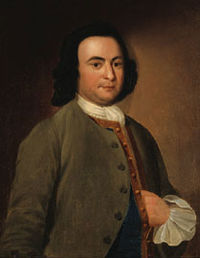
George Mason, (1725-1792) after whom the University is named.
The city of Fairfax purchased and donated 150 acres (0.61 km) of land to the University of Virginia for the college's new location, which was referred to as the Fairfax Campus. In 1959, the Board of Visitors of UVA selected a permanent name for the college: George Mason College of the University of Virginia. The Fairfax campus construction planning that began in early 1960 showed visible results when the development of the first 40 acres (160,000 m) of Fairfax Campus began in 1962. In the Fall of 1964 the new campus welcomed 356 students.
Local jurisdictions of Fairfax County, Arlington County, and the cities of Alexandria and Falls Church agreed to appropriate $3 million to purchase land adjacent to Mason to provide for a 600-acre (2.4 km) Fairfax Campus in 1966 with the intention that the institution would expand into a regional university of major proportions, including the granting of graduate degrees.
On April 7, 1972 the Virginia General Assembly enacted legislation which separated George Mason College from its parent institution, the University of Virginia. Renamed that day by the legislation, George Mason College became George Mason University.
In 1978, the George Mason University Foundation purchased the former Kann's department store in Arlington. In March 1979 the Virginia General Assembly authorized the establishment of the George Mason University School of Law (GMUSL) - contingent on the transfer of the Kann's building to George Mason University. GMUSL began operations in that building on July 1, 1979 and received provisional accreditation from the American Bar Association in 1980. The ABA granted full approval to GMUSL in 1986.
Also, in 1979, the university moved all of its athletic programs to NCAA Division I. Enrollment that year passed 11,000. The university opened its Arlington campus in 1982, two blocks from the Virginia Square-GMU station in Arlington. In 1986 the university's governing body, the Board of Visitors, approved a new master plan for the year based on an enrollment of 20,000 full-time students with housing for 5,000 students by 1995. That same year university housing opened to bring the total number of residential students to 700.
Through a bequest of Russian immigrant Shelley Krasnow the University established the Krasnow Institute for Advanced Study in 1991. The Institute was created to further the understanding of the mind and intelligence by combining the fields of cognitive psychology, neurobiology, and artificial intelligence. In 1992, Mason's new Prince William Institute began classes in a temporary site in Manassas, Virginia. The Institute moved to a permanent 124-acre (0.50 km) site located on the Rt. 234 bypass, ten miles (16 km) south of Manassas, by the year 1997, and is now known as the Prince William Campus. The university graduated more than 5,000 students that following spring.
While George Mason University is young compared to established research universities in Virginia, it has grown rapidly, reaching an enrollment of 30,714 students in 2008. According to a 2005 report issued by the university, enrollment is expected to reach 35,000 students by 2011 with more than 7,000 resident students.
In 2002, Mason celebrated its 30th anniversary as a university by launching its first capital campaign, trying to raise $110 million. The school raised $142 million, $32 million more than its goal. The George Mason University logo, originally designed in 1982, was updated in 2004.
In 2008, the School of Management celebrated its 30th anniversary. Also, in 2008 Mason changed its mascot from the "Gunston" animal to the "Patriot".
Campuses
|
|
This section needs additional citations for verification.
Please help improve this article by adding reliable references. Unsourced material may be challenged and removed. (November 2009) |
Fairfax
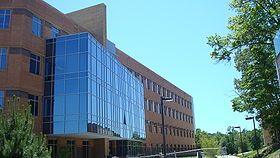
The new Volgenau School of Information Technology and Engineering building.
The main campus of George Mason University is situated on 677 acres (2.74 km) just south of the Fairfax, Virginia in central Fairfax County, approximately 15 miles (24 km) west of Washington, D.C.
The Fairfax campus is served on the Washington Metro by the Vienna/Fairfax-GMU station on the Orange line. A 15 minute shuttle in addition to the CUE bus, free for students with a Mason ID card, serves the students through routes from the Metro station to the University.
Design and construction
In the early 1960s four buildings were constructed around a lawn in Fairfax, appropriately named East, West, North (later, Krug Hall), and South (later, Finley Hall). The first four structures, today dubbed "The Original Four," "around a lawn" were understood as a clear reference to the buildings around The Lawn of the University of Virginia in Charlottesville. In addition, in the words of the architects, the architecture of the buildings was meant to reflect Jeffersonian influence through the use of red brick with buff colored mortar, white vertical columns, and sloped shingled roofs.
Master plans were developed to incorporate further development, which saw new additions such as Fenwick Library and Lecture Hall. By 1979 master plan development was handled by the firm of Sasaki & Associates, which continued to work alongside the university in the years that followed. Student housing first became available in 1977. The 1980s saw the biggest expansion with new buildings being added on each year including the Patriot Center.
Recent years have seen the most activity on campus. Innovation Hall, a new academic building, opened in 2003. Student apartment buildings Liberty Square and Potomac Heights opened in 2004 to accommodate an unprecedented demand from students. The fall of 2005 saw the number of residential students surpass 4,100. The Sandy Creek parking deck and Research I, a four-story 100,000-square-foot (9,300 m) facility that includes faculty offices and instructional and research laboratories, opened in 2006. The latter includes a semi-detached tower that houses the Astronomy Department’s rooftop telescope.
The Fairfax campus is undergoing a massive, $900 million construction campaign (between 2002-2012) that includes a new Information Technology and Engineering building, a new Visual and Performing Arts building, a new dining hall, a renovated Physical Education building (in addition to the recently renovated Aquatic and Fitness Center), and a new residential building. Also, George Mason is planning a new hotel and conference center, and yet another new residential building. Even the roads are changing: the Patriot Circle has received a new roundabout this summer. By 2010, Mason will have over 800,000 square feet (74,000 m) of new building space as compared to 2006. Not only is Mason experiencing a construction boom, but it also has another Master Plan and Library Master Plan in the works. The Fairfax campus is undergoing a complete transformation.
Housing and residence life
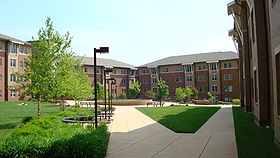
Liberty Square, an upperclassmen residence area which opened in 2003
Fairfax is the only campus of George Mason University with on-campus student housing. There are five housing areas housing approximately 5,000 students: President's Park, DUCC (Dominion Hall, University Commons and Commonwealth Hall), TAP (Townhouses, Student Apartments), YRC (Liberty Square and Potomac Heights) and the newest housing area Chesapeake (Tidewater, Blue Ridge, Shenandoah, Piedmont and Northern Neck). A sixth housing area is currently under construction to house an additional thousand students.
York River Corner includes Liberty Square and Potomac Heights, built in 2003. YRC houses approximately 1,000 upperclassmen combined, with about 500 at each development. Both are fully furnished apartments in two, four, or six-person units.
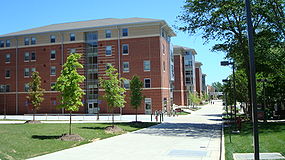
A view of George Mason's Chesapeake housing area.
Chesapeake includes the buildings Tidewater, Piedmont, Blue Ridge , Shenandoah and Northern Neck. Northern Neck consists of Upperclassmen housing in Apartment style rooms, while the other buildings feature combinations of various suite style rooms. The area also contains a Conference Space, Convenience Store, Dining Hall, Fitness Facility, and a future Starbucks (completed in Spring 2009).
President's Park opened in 1989 and is the largest housing area, with more than 1,000 students living in two, three, or four person dorm rooms. President's Park is exclusively for freshman. There are thirteen residential buildings, all named after past U.S. Presidents, surrounding Eisenhower hall in the center, with a diner named Ike's, vending areas, study lounge, and TV lounge.
Dominion Hall, University Commons and Commonwealth Hall, or DUCC, houses approximately one-thousand students, including some freshmen, sophomores and primarily upper-class students. Dominion and Commonwealth Hall were built in 1981 and are five-story buildings offering double-occupancy suite-style rooms for upperclassmen. University Commons was built in 1986 and comprises eight buildings.
Townhouses, Student Apartments, Patriots Village, houses approximately 1,000 upperclassmen. The townhouses and student apartments became available in 1987. Patriots Village, which has modules, became available from 1984 through 1988. There are 35 two-bedroom townhouses located 1/8th of a mile north of the campus on State Route 123. In summer 2008 the Patriot Village area was demolished to make room for a hotel and conference center. Student Apartments were renovated in 2002 and are located inside Patriot Circle, just west of the main quad. They comprise nine three-story buildings of one, two, and three-bedroom units. Patriots Village consists of dozens of permanent modulars located outside of Patriot Circle, just east of Ox Road, offering modular and suite-style units.
Student life
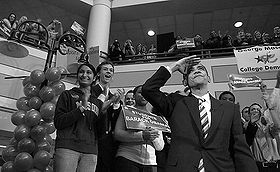
Barack Obama delivering a speech to students at the Johnson Center in 2007.
Johnson Center
The George W. Johnson Learning Center, more commonly known as the Johnson Center or JC, is the central hub on campus, completed in 1995 and named after University President of 18-years, George W. Johnson. Located in the center of campus, the $30 million, 320,000-square-foot (30,000 m) building was built as the first of its kind building on any American campus, acting both as a library and a student union. The ground floor includes a buffet style restaurant named the Bistro, the campus radio station WGMU Radio , a coffee shop named Jazzman's, 300-seat movie theater, and Dewberry Hall. The main floor includes the campus bookstore, a large food court with several fast food restaurants, a patisserie and the ground floor of the library. The second and third floors of the Johnson Center are primarily used by the library, with multiple group meeting rooms, computer labs, and a full service restaurant named George's located on the third floor.
The Johnson Center serves as the center for student life with many activities and productions sponsored by Program Board and Student Government. In 2004 during the Democratic Primaries, Senator John Kerry, the eventual Democratic Nominee for President, visited George Mason University and gave a speech on the floor of the Johnson Center. In 2007, shortly after announcing on his website that he would establish a presidential exploratory committee, Senator Barack Obama gave a speech at the "Yes We Can" rally at the Johnson Center atrium. The next week he formally announced his intentions of running for president.
Center for the Arts
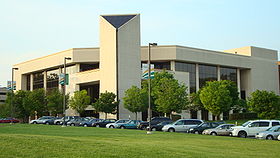
George Mason University's Center for the Arts.
The Center for the Arts includes a 2,000-seat Concert Hall built in 1990. The concert hall can be converted into a more intimate 800-seat theater. Most Center for the Arts events take place here, including operas, orchestras, ballets, and musical and theatrical performances.
Patriot Center
The Patriot Center is a 10,000 seat arena for the Men's and Women's basketball team. The Patriot Center is also host to over 100 concerts and events throughout the year, annually attracting major performers like Bob Dylan, David Bowie, Ricardo Arjona, R.E.M., Linkin Park and the Ringling Bros. and Barnum & Bailey Circus.
The 68,000-square-foot (6,300 m) Aquatic and Fitness Center opened in 1998 at a cost of $11 million. The center includes an Olympic size swimming pool containing eight 50-meter lanes, twenty-two 25-yard (23 m) lanes, two movable bulkheads, and a diving area equipped with two 1-meter and two 3-meter spring boards, a Warm-water recreational pool, Locker rooms, a whirlpool, a coed sauna, and a family changing room.
Fenwick Library was originally built in 1967, with additions in 1974, a tower in 1983, and renovations in 2005-2006. It was named for Charles Rogers Fenwick, one of George Mason's founders. Fenwick Library is the main research library at George Mason. Its resources include: most of the university's books, microforms, print and bound journals, government documents, and maps. Electronic resources include networked and stand-alone CD-ROMs, the libraries' online catalog, a number of databases available through the libraries' membership in various consortia, and Internet access. Another important collection of research materials housed in Fenwick is the Government Documents collection. This collection includes both federal and Virginia state documents. Both sets of documents contain items from the administrative, legislative, and judicial branches of government, and constitute an invaluable source of primary source materials for students and faculty in political science, public policy, sociology, business and other fields. There is also a special GIS center in Fenwick Library which conducts GIS drop-in sessions every week.
George Mason is a member of the Consortium of Universities of the Washington Metropolitan Area, granting it access to resources of thirteen other libraries in the District of Columbia.
Arlington
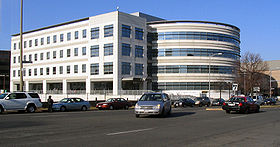
The George Mason University School of Law on the Arlington campus
The 5.2-acre (21,000 m) Arlington campus was established in 1979 by the Virginia General Assembly for the newly founded law school. In 1980, graduate and professional programs were also offered in the building, a converted Kann's department store. Since then the school has grown to offer a multitude of graduate degrees. In 1996, Arlington's campus began its first phase in a three phase campus redevelopment project. In 1998, Hazel Hall was completed to house the law school, the Mercatus Center, and the Institute for Humane Studies. The second phase, to be completed in 2010, is underway for a 250,000-square-foot (23,000 m) building named Founders Hall is to house the Schools of Public Policy, Education and Human Development, Information Technology, Engineering, Management, the Institute for Conflict Analysis and Resolution, Computational Science, and the College of Visual & Performing Arts and academic and student supports services. Arlington's campus is projected to reach an enrollment of 10,000 students by the completion of its redevelopment.
The Arlington campus is served on the Washington Metro by the Virginia Square-GMU station on the Orange line. The station is located approximately two blocks west of the campus.
Prince William
George Mason's Prince William campus opened on August 25, 1997 in Manassas. It is located on 124 acres (0.50 km) of land. The campus offers a high-tech/bio-tech and emphasizes bioinformatics, biotechnology, forensic biosciences educational and research programs in addition to computer and information technology. The campus also offers creative programs of instruction, research, and public/private partnerships in the Prince William County area.
Prince William offers an M.A. in New Professional Studies in Teaching, an M.A.I.S. with a concentration in Recreation Resources Management, a B.S. in Administration of Justice, undergraduate programs in health, fitness, and 'Recreation Resources', graduate programs in exercise, fitness and 'Health Promotion', and nontraditional programs through continuing and professional education in geographic information systems and facility management.
Prince William also boasts the 300-seat Verizon Auditorium, the 110,000-square-foot (10,000 m) Freedom Aquatic and Fitness Center, and a 84,000-square-foot (7,800 m), $40 million Performing Arts Center which opened in 2008. Other buildings on the Prince William campus include the Occoquan Building, which houses various academic, research, and administrative resources including a Student Health clinic, Bull Run Hall, a 100,000-square-foot (9,300 m) building which opened in the fall of 2004, and Discovery Hall, which was completed in 1998 at a cost of $20.4 million.
Loudoun
In the fall of 2005, the university opened a site in Loudoun County, Virginia. Several months later, it announced the gift of 123 acres (0.50 km) of land by Greenvest, LLC, to build a fourth suburban campus. The campus was scheduled to open in 2009. However, the proposal was voted down by the Loudoun County Board of Supervisors, as part of the larger Dulles South project. Greenvest rescinded the gift. Committed to expanding its presence in Loudoun, the university has now proposed a possible joint campus with Northern Virginia Community College. The campus would be located in Brambleton, Virginia.
Mason's current Loudoun site offers several graduate programs; an MA in Business Administration, Masters and doctoral programs in the College of Education and Human Development (CEHD), a graduate degree in nursing, and a Master of Science in telecommunications. The Loudon campus also offers five undergraduate programs; a minor in business and management, certificates in the College of Education and Human Development, a BS in health science, a minor in information technology, and an introductory course in social work. Other graduate level courses, such as those offered by the Department of Information and Software Engineering, are periodically taught at the site.
Ras Al Khaimah
George Mason opened a 'campus' in the Ras Al Khaimah emirate of the United Arab Emirates in 2005. No one ever graduated from the Ras al Khaimah 'campus' and it never grew beyond one building. The Ras Al Khaimah 'campus' nominally offered three undergraduate Bachelors of Science degrees in biology, business administration, and electronics and communications engineering. They subsequently added a course in "educational leadership and management."
On February 27, 2009, Mason announced they would close the Ras Al Khamimah campus at the end of the Spring 2009 semester. University Provost, Peter Stearns, cited that the relationship between George Mason University and the partner foundation in RAK worked smoothly until early 2009. He explained that the foundation would be reducing the financial support as well as attempting to change the academic reporting structure. In an e-mail to students Stearns wrote, "We have not been able to reach agreement with our RAK partner on a budget and administrative structure that, in our judgment, assures our ability to provide an education that meets Mason standards."
学术
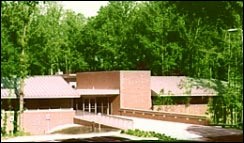
The Krasnow Institute for Advanced Study is located on the Fairfax campus.
The university has strength in the basic and applied sciences with critical mass in proteomics, neuroscience and computational sciences. Research support comes to Mason faculty from such agencies as the National Institutes of Health, NASA, the National Science Foundation and the Defense Advanced Research Projects Agency. Likewise, the Center for Secure Information Systems is designated as a Center of Academic Excellence (CAE) as well as a Center of Academic Excellence in Research (CAE-R) in Information Assurance Education by the National Security Agency.
Mason's Center for History and New Media attracts more than one million visitors to its websites every month.
Mason's Center for Global Education's study abroad program has been rated highly offering dozens of programs ranging from one-week spring break programs to full year programs.
Mason was awarded $25 million in 2005 from the National Institute of Allergy and Infectious Diseases (NIAID), part of the National Institutes of Health, for construction of a Regional Biocontainment Laboratory at the Prince William Campus in Manassas.
Rankings
- U.S. News & World Report ranked George Mason University #1 in its new category of "Up-and-coming National Universities," 2008.
- The Systems Engineering and Operations Research Department is ranked #31 by U.S. News & World Report in 2009 for Best Engineering Schools in Industrial and Manufacturing.
- The School of Public Policy is ranked 1st in the nation for federally-funded public policy, public affairs, public administration and political science research.
- The university is ranked 58th in North America and 75th worldwide by the web-based Webometrics Ranking of World Universities
- 4th most diverse university in the nation, by the Princeton Review in 2008.
- 8th in the world political economy, 30th in public economics by econphd.net.; As of 2008, the Southern Economic Journal ranks Mason economics as 3rd in Methodology and History of Economic Thought, 9th in General Economics and Teaching, 11th in Law and Economics, 25th in Public Economics and 25th in Microeconomics.
- As of 2009, the School of Law is ranked 41st in the nation by US News & World Report
- 51st in the nation graduate Political Science for 2009 by US News & World Report
- 64th in the nation graduate History program for 2009 by US News & World Report
- 45th in the nation graduate Public Affairs program for 2008 by US News & World Report
- 63rd in the nation graduate Nursing program for 2007 by US News & World Report
- 65th in the nation graduate Education program for 2008 by US News & World Report
- 74th in the 2009 list of "Best Undergraduate Business Programs" by U.S. News & World Report
- 152nd in the nation graduate Biological Sciences programs by US News & World Report in 2007
- 6th in the nation graduate Industrial/Organizational Psychology doctoral program. US News and World Report
Schools and colleges
Research at Mason is organized into centers, laboratories, and collaborative programs. These include the College of Humanities and Social Sciences, the College of Education and Human Development, New Century College, the College of Health and Human Services, the College of Visual and Performing Arts, the Institute for Conflict Analysis and Resolution, the Krasnow Institute for Advanced Study, the School of Computational Sciences, the Volgenau School of Information Technology and Engineering, the School of Law, the School of Public Policy, the College of Science, and the School of Management. In addition, Mason's Office of the Provost includes research centers that deal with economics, global education, and teaching excellence.
In addition to a business undergraduate major and minor, Mason's School of Management has graduate programs for the Master of Business Administration degree (MBA) with a wide variety of concentrations/specializations, an Executive Master of Business Administration degree (EMBA), a Master of Science in Accounting (MSA), a joint MBA/MSA degree and a Master of Science in Technology Management degree. It is one of only 15 business schools in the U.S. to require at least one global residency for the MBA degree and the only one to require three global residencies for the EMBA degree. It is also the only U.S. business school to offer an EMBA cohort for executives who already work in, or are interested in working in, the U.S. national defense industry.
体育运动
Main article: George Mason Patriots
See also: George Mason Patriots men's basketball and 2005–06 George Mason Patriots men's basketball team
The school's sports teams are called the Patriots. The university's men's and women's sports teams participate in the NCAA's Division I, and are members of the Colonial Athletic Association, or CAA. The school's colors are green and gold. George Mason has two NCAA Division I National Championship to its credit; 1985 Women's Soccer and 1996 Men's Indoor Track & Field.
George Mason University was catapulted into the national spotlight in March 2006, when its men's basketball team qualified for the Final Four of the NCAA Men's Basketball Tournament by defeating the Michigan State Spartans, the defending champion North Carolina Tar Heels, the Wichita State Shockers, and the top-seeded Connecticut Huskies. Their "Cinderella" journey ended in the Final Four with a loss to the eventual tournament champion Florida Gators by a score of 73-58. As a result of the team's success in the tournament, the Patriots were ranked 8th in the final ESPN/USA Today Poll for the 2005-06 season. The New York Times, The Washington Post, Baltimore Sun, and USA Today featured the story on their front pages, and was ranked by several publications as the sports story of the year.
The Patriots, who had never won an NCAA tournament game before 2006, became the first team from the CAA to crash the Final Four and were the first true mid-major conference team since 1979 to do so (that year, the Larry Bird-led Indiana State Sycamores as a #1 seed, and the Penn Quakers as a #9 seed both reached the Final Four). As #11-seeds, the 2006 Patriots also tied the 1986 LSU Tigers as the lowest-seeded team ever to reach the Final Four.
In 2008, the Patriots returned to the NCAA Tournament after winning the CAA Tournament. They were given a 12 seed and matched up against 5th-seeded Notre Dame. The Patriots were unable to make another miracle run, losing to the Irish by a score of 68-50.
[edit] Organizations
George Mason offers more than 200 clubs and organizations, including 16 fraternities, 15 sororities, 24 International-student organizations, 25 religious organizations, a student programming board, student government, club sports, speech and debate teams, and student media. Mason also offers an Army ROTC program, called The "Patriot Battalion." Mason's club sports include ultimate frisbee, crew, equestrian, field hockey, football, lacrosse, underwater hockey, fencing, and rugby.
Media
Mason offers two official print publications, Broadside, the student newspaper, and the Mason Gazette, the University-published newspaper. Mason also operates a Campus radio station, WGMU Radio. The online radio station offers music, entertainment, news, and public affairs relating to the University. The Mason Cable Network offers entertainment and information on the public-access channel 89. Mason also sponsors several student-run publications, including the Broadside, a weekly student newspaper, Connect2Mason, an online media and news convergence Web site, VoxPop, a student literary magazine, Phoebe, a graduate literary journal, So to Speak, a feminist literary journal, GMView and Senior Speak, an annual yearbook publication and video, New Voices in Public Policy, School of Public Policy student journal, DigitalCampus, a podcast from the Center for History and New Media, and Hispanic Culture Review, a student bilingual (Spanish/English) journal on Hispanic literature and culture.
Between approximately 1993 and 1998, George Mason University was also the home of "The Fractal: Journal of Science Fiction and Fantasy."
In Fall 2008, the satirical online newspaper, The Mason Squire, premiered. The site featured fake news stories, criticizing the university, rapidly gaining popularity with the student population. The newspaper's mottos were "Because fake news doesn't report itself" and "Fake news just got a whole lot sexier."
Fraternity and sorority life
See also: List of Fraternities and Sororities at George Mason University
George Mason University does not have traditional Fraternity & Sorority housing or a "Greek row." Several Panhellenic Council organizations have, however, established "Living/Learning Floors" in the University Commons. Alpha Omicron Pi has had a floor since 2004, Gamma Phi Beta has had a floor since 2006, and Alpha Phi has had a floor since 2007.
Officially, Mason refers to "Greek Life" as "Fraternity & Sorority Life" to avoid confusion with the Hellenic Society club, a student organization focusing on the people and culture of Greece.
Most organizations in the Interfraternity Council (IFC) and Panhellenic Council (PHC) hold one or two large charitable events each year. Most organizations in the National Pan-Hellenic Conference (NPHC) and Multicultural Greek Council (MGC) hold a series of smaller charitable events throughout the year. The NPHC is also known for its annual Step Show.
The most well-known event associated with Fraternity & Sorority Life on campus is held each spring and is called Greek Week. This annual event includes competitive sporting and trivia events, charitable fund raising, and is usually ended with Greek Sing. Organizations participating in Greek Sing put together 10-15 minute themed shows which have included extravagant costumes, set designs, lighting displays, multimedia presentations, dances, singing, acrobatics, and more.
PHC holds a formal recruitment each fall. Informal recruitment is held in spring. Many PHC organizations also offer continuous open recruitment (or continuous open bidding) after the designated recruitment period. IFC has a designated one-week rush period in the fall and spring. This week is regulated and monitored, but participants are not registered or tracked.
Presidents past and present
- Lorin A. Thompson, (1966-73)
- Vergil H. Dykstra, (1973-1977)
- Robert C. Krug, (1977-1978)
- George W. Johnson, (1978-1996)
- Alan G. Merten, (1996-present)
Notable alumni
Corporate/non-profit
- L. Kevin Kelly, CEO, Executive recruiting firm Heidrick & Struggles, Inc
- Muna Abu-Sulayman, Executive Director, Kingdom Foundation
- Zainab Salbi, President, Women for Women International
- Alan Harbitter, Chief Technology Officer, Nortel Government Solutions
- Raymond Winn, Partner, Deloitte & Touche
Government and politics
- Anna E. Cabral, 42nd Treasurer of the United States.
- Kathleen L. Casey, Commissioner of the U.S. Securities and Exchange Commission
- Sean Connaughton, Virginia Secretary of Transportation, Former U.S. Maritime Administrator
- Ken Cuccinelli, Attorney General of Virginia (2010-)
- Bob Deuell, Texas State Senator
- Deborah Hersman, Chairman, National Transportation Safety Board
- Mohammad Khazaee, Representative of the Islamic Republic of Iran to the United Nations
- Mark B. Madsen, Utah State Senator
- Mike Mazzei, Oklahoma State Senator
- Paul F. Nichols, Virginia House Delegate
- Nancy Pfotenhauer, adviser to the John McCain presidential campaign 2008
- Karl Rove, former Deputy Chief of Staff to President George W. Bush
- William P. Winfree, NASA
Literary and media
- Richard Bausch, novelist
- Sharon Creech, novelist of children's fiction
- Carolyn Kreiter-Foronda, Poet Laureate of Virginia
- Mark Winegardner, author
- Rebecca Wee, poet
- Chad Ford, sports journalist and founder of ESPN Insider
- Angie Goff, Traffic Presenter, WUSA-9 TV
- Hala Gorani, News Anchor, CNN
- Imad Musa, Washington Senior Producer, Al Jazeera English
- Brian Krebs, Journalist
- Stephen Moore, Journalist and Policy Analyst
- Susan Rook, former News Anchor, CNN & CNN Talkback Live
- Brian Van De Graaff, Weather Presenter, WJLA-7 TV
- Roshini Thinakaran, Documentary filmmaker
Sports and entertainment
- Julius Achon, Ugandan middle distance runner, currently holds the 800m American Collegiate Record
- Abdi Bile, Olympic runner
- Shawn Camp, Relief Pitcher, Toronto Blue Jays
- Jennifer Derevjanik, Point guard, Phoenix Mercury
- Ben Dogra, sports agent
- John Driscoll, Actor
- Archie Kao, Actor
- Mike Kohn, Olympic bobsledder
- Dayton Moore, General Manager, Senior Vice President of Baseball Operations, Kansas City Royals
- Rob Muzzio, Decathlon Champion, Olympic Athlete
- Jennifer Pitts, Miss Virginia 2002, Miss Virginia USA 2005
- Maegan Phillips, Miss Virginia USA 2009
- Chris Widger, Catcher, MLB (Free Agent)
- Chad Dukes (radio personality), radio host, WJFK-FM
- Kyle "K-Dog" Benham, Associate Producer/radio personality
- Kristi Lauren Glakas, Miss Virginia Teen, Miss Virginia USA 2004, USA 1999 Miss Virginia 2005
- Gabe Norwood, Philippine Basketball Association player and member of the 2006 NCAA Final Four team
Other
- Anousheh Ansari, space tourist
- Sibel Edmonds, former Federal Bureau of Investigation translator
- Jon Gettman, marijuana reform activist and leader of the Coalition for Rescheduling Cannabis, longtime contributor to High Times magazine
- Frederick I. Moxley
Notable faculty
College of Humanities and Social Sciences
- Mary Catherine Bateson, daughter of American cultural anthropologist Margaret Mead, former Clarence J. Robinson Professor in Anthropology and English, now Professor Emerita. Now retired.
- Roger Wilkins, Pulitzer Prize winner for coverage of the Watergate scandal (along with Bob Woodward and Carl Bernstein while he was working at The Washington Post.) Now retired.
- Richard Norton Smith Presidential historian & former director of five presidential libraries [14].
- Carma Hinton, documentary flimmaker. Credits include The Gate of Heavenly Peace
- Shaul Bakhash, scholar of Persian studies. Husband of Haleh Esfandiari.
- Peter Mandaville, professor of international affairs and scholar of political Islam.
- Hugh Heclo, professor of American politics and winner of John Gaus award.
- Martin Sherwin, Pulitzer Prize winner for his biography of Robert Oppenheimer
- Rex A. Wade, professor of Russian history.
Department of Economics
- Peter Boettke
- Donald J. Boudreaux
- James M. Buchanan, Nobel Prize-winning economist (1986)
- Bryan Caplan
- Tyler Cowen
- Robin Hanson
- Arnold Kling
- Daniel B. Klein
- Peter T. Leeson
- Kevin McCabe
- Russell Roberts
- Vernon Smith, Nobel Prize-winning economist (2002)
- Alex Tabarrok
- Gordon Tullock
- Richard E. Wagner
- Walter E. Williams
College of Science
- Abul Hussam, inventor of the Sono arsenic filter, for which he received the 2007 sustainability prize awarded by the National Academy of Engineering
- James Trefil, physicist, and author
- Edward Wegman, statistician
School of Public Policy
- Kenneth Button
- Desmond Dinan
- Michael Hayden
School of Management
- Jim Larranaga, Mason's head men's basketball coach since 1997, including the Final Four run
- Anthony Sanders, Distinguished Professor of Real Estate Finance
参考文献
- ^ http://www.nacubo.org/Documents/research/2009_NCSE_Public_Tables_Endowment_Market_Values.pdf
- ^ George Mason University's Visual Identity Guide George Mason University
- ^ "City Map." City of Fairfax. Accessed October 20, 2008.
- ^ "America's Best Graduate Schools 2008: Top Law Schools". U.S. News & World Report. http://grad-schools.usnews.rankingsandreviews.com/usnews/edu/grad/rankings/law/brief/lawrank_brief.php. Retrieved 2008-11-05.
- ^ "Rankings: Political Economy". EconPhD.net. http://www.econphd.net/rank/rpublc.htm. Retrieved 2008-11-05.
- ^ Teles, Steven Michael (2008). The rise of the conservative legal movement. p. 182.
- ^ Vault Editors (2006). The Law School Buzz Book. p. 458.
- ^ http://www.pw.org/content/2010_mfa_rankings_top_fifty_0
- ^ http://grad-schools.usnews.rankingsandreviews.com/best-graduate-schools/top-computer-science-schools/rankings/page+3
- ^ http://www2.timesdispatch.com/rtd/news/local/education/article/GMUU15_20091014-221605/299431/
- ^ A Brief History of George Mason University George Mason University
- ^ "2008-2009 Facts and Figures". www.gmu.edu. George Mason University. http://www2.gmu.edu/resources/visitors/masonfacts/.
- ^ Fall Headcount Enrollment State Council of Higher Education for Virginia
- ^ [1] Mason Shuttle Services
- ^ [2] Cue Bus System
- ^ http://arlington.gmu.edu//newconstruction.html
- ^ Loudoun Supervisors Quash Dulles South Project The Washington Post
- ^ Joint GMU-NVCC campus proposed for Loudoun Loudon Times-Mirror
- ^ The Ras Al Khaimah Campus George Mason University
- ^ George Mason U. Will Close Its Campus in the Persian Gulf Mills, Andrew. The Chronicle
- ^ George Mason University, Among First With an Emirates Branch, Is Pulling Out The New York Times
- ^ Education Leadership George Mason University Graduate School of Education
- ^ [3]
- ^ National Centers of Academic Excellence Institutions
- ^ George Mason University Receives $25 Million Federal Award For Construction of a Regional Biocontainment Laboratory George Mason Media and Public Relations
- ^ [4] US News & World Report
- ^ George Mason University
- ^ George Mason University
- ^ World Universities' ranking on the Web: Top USA & Canada
- ^ "Demographics — Diverse Student Population". The Princeton Review. http://www.princetonreview.com/college/research/rankings/rankingDetails.asp?categoryID=2&topicID=20. Retrieved 2008-11-15.
- ^ econphd.net
- ^ Therese C. Grijalva and Cliffor Nowell, "A Guide to Graduate Study in Economics: Ranking Economics Departments by Fields of Expertise," Southern Econ. Journal, April 2008, Vol. 74, No. 4, pp. 971-996
- ^ [5]
- ^ [6] US News & World Report
- ^ US News & World Report
- ^ [7] US News & World Report
- ^ [8] US News & World Report
- ^ [9]
- ^ [10]
- ^ [11]
- ^ U.S. News: Best Graduate Biological Sciences Programs (2007) The Consus Group
- ^ Department of Psychology George Mason University Department of Psychology
- ^ Research and Scholarship George Mason University
- ^ [12] Yahoo! Sports
- ^ [13]
- ^ McKinnon, John D. (August 13, 2007). "Karl Rove to Resign At the End of August". The Wall Street Journal. http://online.wsj.com/article/SB118698747711695773.html. Retrieved April 12, 2010.
- ^ http://www.carolynforonda.com/
External links
Listen to this article (info/dl)
This audio file was created from a revision of George Mason University dated 2006-01-16, and does not reflect subsequent edits to the article. (Audio help)
More spoken articles
- Official website
- Official Athletics website
- Connect2Mason Student Run Blog



